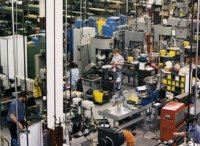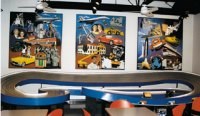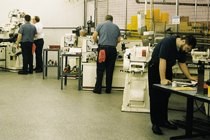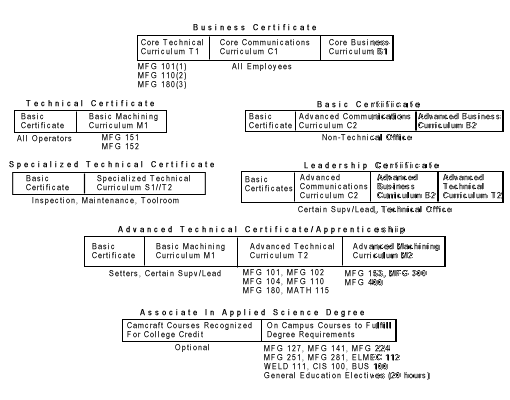Do-It-Yourself Training
Training and recruitment of good manufacturing people is like the weather, in that everyone talks about it. But unlike our ability to influence the weather, there are things a shop can do about training and recruitment. This story describes one shop's innovative and successful approach to this vexing problem.
Share



Takumi USA
Featured Content
View More
Autodesk, Inc.
Featured Content
View More






Hwacheon Machinery America, Inc.
Featured Content
View More.png;maxWidth=45)
DMG MORI - Cincinnati
Featured Content
View MorePerhaps it's because Bern Bertsche admittedly "does not possess strong mechanical aptitude" that he relies on and trusts others in his company with those skills. It may also be true for that same reason Mr. Bertsche appreciates the difficulty of acquiring these skills and therefore how valuable they are.
As president of Camcraft, a Chicago-area precision component manufacturer, Mr. Bertsche has overseen tremendous business growth—double-digit increases for the past four years. Camcraft has over 200 employees, which makes it one of the nation's largest screw machine shops.
Like every other metalworking shop, Camcraft needs highly skilled workers to keep going and growing. Camcraft has enjoyed the metalworking "good times" of the past six years, but like other shops, has found the personnel pool too shallow to maximize their participation in these good times.
What's a company to do? Camcraft's approach to the problem is two-pronged. First, they develop the skill sets of current employees internally. The second thrust is to go beyond the walls of the shop and bring in young people to expose them to manufacturing. This is an investment in the future.
Camcraft's internal and external activities are producing benefits. Here's what they're doing and how it might be a process for your shop to emulate.
Keeping Your People
A major objection for many shops trying to train personnel is the time and expense that go into the effort. Doing the job right, at least in larger operations, means dedicated people to organize and run the training operation. The bad news is that all too often the beneficiaries of the training take what they've learned elsewhere.
Don Slawinski, Camcraft's training facilitator, says that the key to successful in-house training, or any company sponsored training, is a stable workforce. "We try very hard to instill a culture of mutual trust and respect between the company and the employee."
Camcraft has a relatively low employee turnover rate. It's a nice place to work and people want to stay there. "Probably if a shop is a revolving door with people coming in and going out at high rates, a training program like ours is not going to work well there," says Jerry Benish, director of human resources. "We have structured our program on a long-term basis. The key here is to start with a willing and engaged work-force. Such a work-force is created by the pro-learning company culture, which needs to be in place well ahead of a comprehensive training program."
Teach Basics First
The first step that Camcraft took in establishing a training program was to hire a director of training. He was brought in to develop programs directed primarily at existing personnel.
To establish a baseline of competency, two courses were set up almost immediately: basic English and math courses. All employees, including Mr. Bertsche, took these classes. They helped establish a common starting point from which additional classes could be launched.
Camcraft has several foreign-born employees. The initial tests were administered in their languages, Spanish and Polish. For those who needed more help with English, courses in "English as a second language" (ESL) were offered. Participation was optional but was encouraged by the company.
Attendance was 50 percent company time and 50 percent personal time. "The ESL courses were very successful," says Mr. Benish. "Completion of these courses required passing an eighth-grade level proficiency test. The course served as a foundation for these employees to successfully participate in the larger program."
There were incentives for employee participation. "We felt a demonstration of the company's commitment to training was best expressed by a participation bonus," says Mr. Bertsche. Upon completion of the in-house math and English courses, each employee received $100. Those who opted for the ESL course, held off-site at a local community college, received $250 for successful completion and $150 toward the cost of the course.
Once a baseline of basic learning skills was established, Camcraft was ready to begin its training program in earnest. "It's important that employees be as close as possible to the same page at the start of a program like ours," says Mr. Benish. "These basic courses have accomplished that for us."
Core Competencies
Camcraft's training program consists of a series of certificates. These represent levels of achievement within the training curriculum. The first level of certification involves basic core technical competencies.
After the remedial classes in English and math are passed, all Camcraft employees move into the Basic Certification program. The first class in this program covers company culture. It examines the mission statement for Camcraft as well as company policies, general shop safety issues (hazardous materials, machine lockout procedures), quality, and the company training program. It's like an orientation.
Depending on the employee's job function, the basic certificate offers courses in three operations areas: basic technical skills, core communications curriculum, and a business curriculum.
The second step, the Technical Certificate, is composed of specific courses in the core skills needed in the Camcraft shop: shop math, blueprint reading, basic statistical process control, basic metrology, and additional reading and language courses. These courses are scheduled regularly. Participation is voluntary but strongly recommended. Peer pressure is generally sufficient motivation for reluctant employees.
According to Mr. Benish, the training program is designed to be a positive experience for employees, and there is no penalty for failure. "The program stresses skill improvement for your current job with emphasis on the changing nature of the screw machine business. As a result of changes in the business, skills requirements change, which creates the need for employees to adapt through training. It's also a purpose of the training to teach people-skills such as teamwork and respect for others that carry over into the employee's private life."
Learning To Learn
A benefit from ongoing training programs that is less obvious at first glance is that it tends to create an environment for learning. With virtually full participation of employees at all levels of the organization, the company culture includes learning. It has become a norm to be "in school."
Creating a penchant for training also makes acquisition of new skills less traumatic for employees. For example, some of the new machine tools that Camcraft has purchased are much more sophisticated than the machines they replaced. It's much easier for the operators and setup people to learn the new equipment because they are, in effect, being trained to learn how to learn. It has proven to be very powerful and positive for new skill acquisition.
Career Growth
Upon receipt of the basic certification, employees are encouraged to continue through the program by participating in specialized technical courses. These focus more tightly on operations such as machine setup and operation and more advanced SPC and metrology classes.
The training program builds on itself with each certification. As the employees successfully move from the basic to the technical level, they are qualified to participate in an apprenticeship program. There are currently 45 employees enrolled in the apprenticeship program.
It's an accredited 8,000-hour program that awards journeyman status upon completion. Many of the courses were developed in conjunction with the nearby College of DuPage, and many apply these classes toward an associate of applied science degree from the college. Some employees eventually take those credits to a four-year college in pursuit of a bachelor's degree.
"The whole idea," says Mr. Bertsche, "is to give our people a path to better themselves professionally and personally. I'm confident that our company culture makes Camcraft an attractive place to work. We haven't seen a migration of people from our company. The opposite is occurring. Our training program has become a recruitment tool for Camcraft."
Individual training history is kept for each employee. They can see what courses they have taken and get a feel for additional classes they may need for a given certificate.
Employees can schedule courses when it's best for them. There is no time pressure for completion of a certificate. The idea is to keep working toward a goal but at a pace that's comfortable for the employee.
Training Center
Camcraft recently dedicated a 1200-square-foot training area within the plant. It's been equipped with new machine tools and consists of a classroom and separate shop floor for the training machine tools.
While many shops opt to do their hands-on training on production equipment, Camcraft decided that a separate area would be much less disruptive. Moreover, they were concerned about any negative influence on quality because training on the production floor would involve customer parts.
It's A Must
In-house training is not a choice for Camcraft; it's a necessity. The dollars allocated to develop and maintain the training program are an investment that is intended to have a return.
"Ours is a very competitive business," says Mr. Bertsche. "We're under the gun from our customers to produce better parts in smaller quantities—with shorter lead and delivery times while maintaining price. Better technology with people trained to take advantage of the technology is our competitive edge and key to our future."
Related Content
How to Pass the Job Interview as an Employer
Job interviews are a two-way street. Follow these tips to make a good impression on your potential future workforce.
Read MoreSame Headcount, Double the Sales: Successful Job Shop Automation
Doubling sales requires more than just robots. Pro Products’ staff works in tandem with robots, performing inspection and other value-added activities.
Read MoreFinding the Right Tools for a Turning Shop
Xcelicut is a startup shop that has grown thanks to the right machines, cutting tools, grants and other resources.
Read MoreInside Machineosaurus: Unique Job Shop with Dinosaur-Named CNC Machines, Four-Day Workweek & High-Precision Machining
Take a tour of Machineosaurus, a Massachusetts machine shop where every CNC machine is named after a dinosaur!
Read MoreRead Next
Building Out a Foundation for Student Machinists
Autodesk and Haas have teamed up to produce an introductory course for students that covers the basics of CAD, CAM and CNC while providing them with a portfolio part.
Read MoreRegistration Now Open for the Precision Machining Technology Show (PMTS) 2025
The precision machining industry’s premier event returns to Cleveland, OH, April 1-3.
Read More5 Rules of Thumb for Buying CNC Machine Tools
Use these tips to carefully plan your machine tool purchases and to avoid regretting your decision later.
Read More













































.jpg;maxWidth=300;quality=90)








